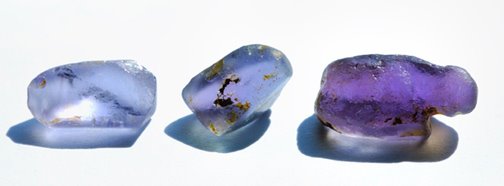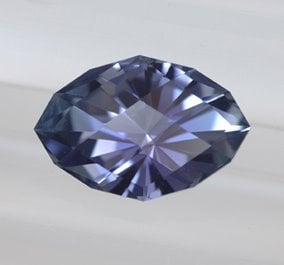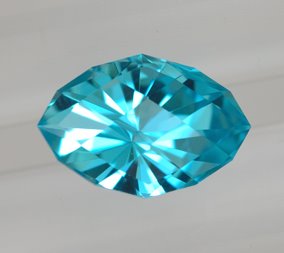Purple Cuprian; A dilemma:
By Richard W. Wise, G.G.
I know what you're thinking. Did he fire six shots or
only five? Well, to tell you the truth, in all this
excitement, I've kinda lost track myself. But being as
this is a.44 Magnum, the most powerful handgun in the
world, and would blow your head clean off, you've got to
ask yourself one question: Do I feel lucky? Well, do ya
punk?"
Clint Eastwood
As tourmaline aficianados know, there are few truly rare colors of
tourmaline. A pure yellow without a stong green secondary hue is
quite rare and I have never seen a true violet but until recently,
purple was the one spectral color that absolutely did not exist in
tourmaline. Yes we had purplish reds but until last year when the
/Alta Lighona/ tourmalines from Mozambique entered the market, never
a stone with a purple primary hue. (pictured above: 15.5 carat
purple Mozambique cuprian tourmaline courtesy Pala International)
In early 1989 when the first curpian tourmalines from /Paraiba/
appeared in the market in Brazil some were sold unheated. Most of
these stones were a dark toned greenish “sapphire” blue, a “Thai
sapphire blue” to be precise. In those days, blue was the most
expensive, elusive and sought after color in tourmaline. Rumors
whispered of a pure blue gem that was reputed to rival the finest in
Burmese sapphire. This was the holy grail of tourmaline. I recall
holding on to one parcel of natural dark blue /Pariaba/ for several
years before I burned them just in case the demand for the medium
electric blue proved to be a passing fancy. Well, as we know it did
not and when I finally did heat it, the result was a half dozen pure
medium toned visually pure Carrribean blue gems that I sold at a
substantial profit.
Since that time I have seen many examples of blue tourmaline
including the famous /Manoel Mutuca/ (described by Proctor as
“sapphire blue” see Gems & Gemology, Spring 1985, p.11)) and /Santa
Rosa/ material but none (at least so far) with a true pure blue hue.
Blue tourmaline always has a distinct greenish secondary hue which
becomes quite evident when it is compared stone to stone with fine
sapphire. Blue tourmaline can be exceptionally beautiful but it looks
like tourmaline not sapphire.
To burn or not to burn or /“Do I feel lucky? Well, do ya punk?”/
With the entry of Mozambique curprian tourmaline we have a dilemma
similar to the situation with the early Brazilian curprian
tourmaline namely that some of the unburned material has a rich pure
purple hue that reminds one of Siberian amethyst or fine purple
sapphire. The difference is that unlike the rather dull greenish blue
unheated Paraiba, this stuff is beautiful,
The Mozambique purples have a hue that is rich and pure. So, to burn
or not to burn, that is the question, according to both Gene Flanigan
from Precision Gems and Josh Hall at Pala International, these deep
purples are also the best candidates for the oven, they heat to a
neon pure medium “Paraiba” blue.

Some dealers have chosen the obvious solution. If you want a pure
purple but burnable stone they will charge the same price as for the
neon blue.(pictured above: unheated cuprian rough from Mozambique).
Pictured below is an exceptional 1.89 carat custom cut Carribean blue
cuprian stone cut from the center piece of rough. After and before;
the first image shows the cut stone before heating. The second image
shows the stone after the heating process was completed. The stone,
currently available for sale at rwwise.com was cut by Gene Flanigan a
very talented lapidary artist from upstate New York. (Images courtesy
Gene Flanigan: precisiongem.com)


Will purple tourmaline go the way of fine star sapphires that hardly
exist anymore because they can be burned and faceted? I don’t think
so, some of the fine purples simply possess problematic inclusions
that make them risky candidates for burning. I found an 8.19 carat
oval, a lovely example of Mozambique purple on my last trip to Asia.
This stone faces up clean but under magnification shows long growth
tube inclusions and cannot be burned. It is out having its picture
taken and will be posted in a later blog. Logically purple cuprian
tourmaline will have a two track price structure. Stones with a high
degree of clarity under the loupe will sell for prices that may be
double that for stones with certain types of inclusions whether
visible or not.
Bits and Pieces:
I get lots of emails. Don’t think I’m not grateful. Every once in a
while a real interesting one comes through the mailbox. take this
on:
Position Available:
Dear Mr Wise,
We are Stargate, diamond trading division of Ebenhaezer Bank
Consulting Group of Belgium, operating in thirty countries worldwide.
We have read your blog regarding the appraisal of stones by qualified
experts. We have constant need of qualified gemologists, expert in
assessing ROUGH DIAMONDS, and have great difficulty identifying where
they can be located.
We offer good working conditions, contracts, and a fair remuneration.
A special need has arisen in Bangui, Central African Republic, where
we are currently (this week) accepting a large consignment. We
require the services of a qualified gemologist, expert in rough
diamonds, to assist our team there. Would you be kind enough to
assist us at your earliest convenience?
Yours sincerely,
Lucilla Arioti
Global Client Relationship Manager, EMEA
I am not familiar with Stargate but believe the lady is serious. She
even called and left a message on my machine. So if you are a
gemologist in search of adventure give Lucilla a jingle. This time
next month you could looking at sparklies and sipping pina colodas in
beautiful downtown Bengui. As for myself I’d love to go along but I
can’t give up my day job but when you get there be sure to drop me a
line and oh do **be sure to take along a flack jacket.
New Site with excellent online library of inclusions:
Got an email from a French gemologist: Marie-France Boursier-Brard.
Ms Boursier-Brard has developed an excellent site with online images
of inclusions. The site is quite comprehensive and well organized.
Just click on: www.gemmes-inclusions.com